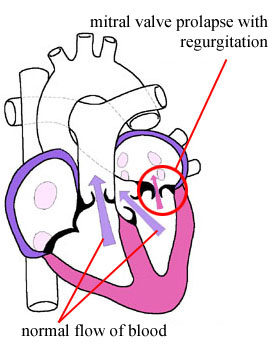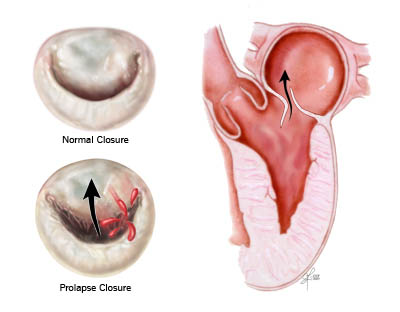Mitral Valve Prolapse - Symptoms, Treatment, Surgery
Mitral Valve Prolapse - Symptoms & Treatment
Before we discuss the details of mitral valve prolapse symptoms and treatment, let's make sure we understand the anatomy and functioning of the mitral valve in the human heart.


What is the mitral heart valve?
The mitral valve is one of four heart valves inside the human heart. The mitral valve controls the flow of blood between two chambers in your heart called the left atrium and the left ventricle. In normal functioning hearts, blood flows in one direction across the mitral valve - from the atrium to the ventricle.
Unlike the other three heart valves (aortic, pulmonary, tricuspid), the mitral valve is unique in that it has only two leaflets. The other human heart valves each have three tissue leaflets.
When the heart relaxes, the two mitral leaflets (also known as flaps) swing open to let blood flow from the atrium to the ventricle. Here, in this three-dimensional reconstruction of the heart, you can see the mitral valve opening-and-closing within the human heart.
What Is Mitral Valve Prolapse?
If you have a mitral valve prolapse, the leaflets of the mitral valve do not seal properly. One of the leaflets moves back into the atrium when the heart beats. Because of the mitral valve prolapse, blood flows back into the heart. This is referred to as a leaky heart valve, or more specifically mitral regurgitation.
As a result of mitral regurgitation, the heart is forced to work "overtime" to re-pump blood through the heart and body. According to the Mayo Clinic, mitral valve prolapse can trigger several problems including a thickened heart, arrhythmias and infection.
However, most of the time, mitral valve prolapse is not a serious condition, even though some patients report palpitations or sharp chest pains. According to the Texas Heart Institute, most patients do not need treatment.
Reports suggest that one in twenty Americans have mitral valve prolapse. People are usually born with mitral valve prolapse as a congenital condition. Interestingly enough, more women have mitral valve prolapse and mitral valve prolapse symptoms than men. Some studies show it affects six percent of all women.
Compared to other heart valve disorders (e.g. aortic stenosis), mitral valve prolapse (also referred to as MVP) is the most common valvular disorder.
What are mitral valve prolapse symptoms?
The Cleveland Clinic suggests that the symptoms and problems of mitral prolapse are:
-
Feeling like your heart is racing or is skipping beats
-
Heart Palipitations
-
Chest pain that comes now and then
-
Shortness of breath
-
Dizziness
-
Anxiety
Your doctor can diagnose mitral valve prolapse during a regular exam. When listening to your heart with a stethoscope, your doctor may hear a clicking sound. The defective heart valve leaflet can make a pronounced "click" as it opens and closes. If blood is flowing back into the atrium, your doctor will hear a "whooshing" sound. This sound is called a heart murmur and is caused by the mitral valve prolapse.
To find out if you have mild, moderate or severe mitral regurgitation due to mitral prolapse, your cardiologist may require an echocardiogram. An echocardiogram provides a picture of your heart that shows and quantifies heart valve efficiency as blood flows through the heart. Echocardiograms and other medical tests can help your doctor determine if your mital valve needs surgical repair or replacement.